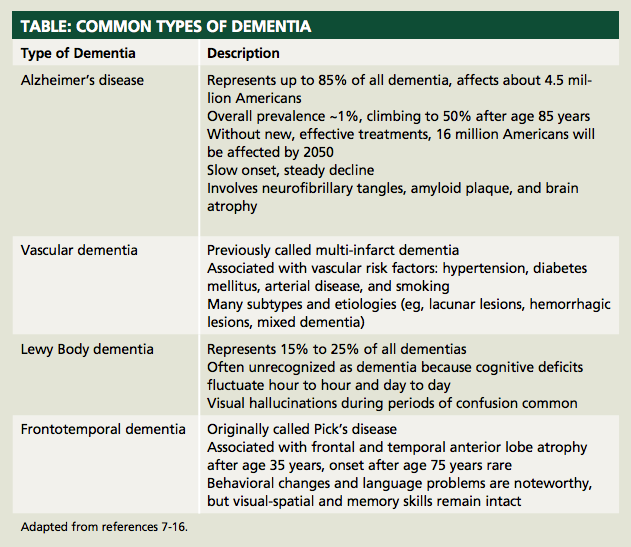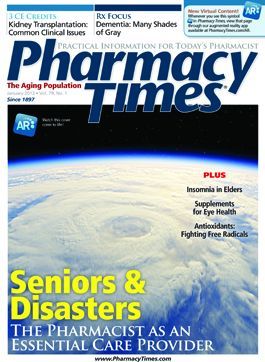Dementia: Many Shades of Gray
Alzheimer's may be the most recognized form, but it does not account for all dementias in the elderly.
Alzheimer's may be the most recognized form, but it does not account for all dementias in the elderly.
For most Americans, the word “dementia”—or “Old Timers Disease” in the vernacular—is a frightening catch-all for end-of-life memory loss. The media is replete with stories about stigma,1 poor care for dementia patients,2,3 the belief that dementia is inevitable,4,5 and a future burdened with more dementia patients and fewer societal resources to care for them.3 Some clinicians even think this way, unaware that a diagnosis of dementia isn’t always Alzheimer’s disease.
All dementias have one thing in common: irreversible, incurable deficits. Early detection can help alter the clinical course of specific dementias, however. Each presents uniquely, but differs in short- and long-term memory deficits, impact on judgment, disturbed higher cortical functions, and personality changes.6 Most dementia cases fall into 4 types, although there are many others (Table7-16 ). Additionally, many patients present with mixed dementia or mild cognitive impairment. Diagnosis—a process that can take up to 6 hours of testing—can be tricky.
Alzheimer’s Dementia
In Alzheimer’s dementia (AD), onset is slow. AD begins with language difficulties, including aphasia (language disturbance), apraxia (inability to carry out motor functions), and agnosia (failure to recognize or identify objects). Patients often create new words for items: they may call a pencil a list-writer, or a key a door-turner. People may excuse mild AD as normal cognitive decline or senility—what they think of as “normal” aging.
AD’s cognitive decline progresses in a linear fashion, starting with shortterm memory loss (mild disease) with long-term memory and some reasoning remaining intact. Functional at the mild stage, patients may not be diagnosed until the moderate point, when they already have considerable cognitive difficulty. Mood and personality disorders, including possible psychotic symptoms, emerge, and patients may have extrapyramidal features like bradykinesia. At the severe stage, all memory is gone and the patient is incapacitated. Patients who fit this pattern are diagnosed with “probable AD,” because only autopsy can confirm the diagnosis. All treatment, including the acetylcholinesterase inhibitors and mementine, is symptomatic.17
With overall median survival around 4.2 years, women of all ages have better survival rates than men.18 At age 70 years, women can be expected to live 8 years; men for 4.4 years. Risk factors that shorten survival include congestive heart failure or ischemic heart disease, diabetes, extrapyramidal signs, and frontal lobe release signs. Gait disturbances and a history of falls also contribute to poorer survival rates.19
Vascular Dementia
Patients who develop vascular dementia (VaD) have positron emission tomography scans that show hypoperfusion and hypometabolism in the frontal lobe, unlike the parietotemporal pattern observed in AD.20 If hypertension is the root cause, impairment is more diffuse than the focal symptoms associated with thrombotic occlusions.21 Mild VaD begins with changes different from those associated with AD. With disease progression, AD and VaD patients have similar clinical pictures.22,23
When diagnosed early, VaD can be slowed by treating underlying causes to decrease risk of future brain infarcts.23 Antihypertensives, antiplatelet therapy, smoking cessation, and reduction of dietary fat are common interventions.

Lewy Body Dementia
Patients with Lewy body dementia (LBD) have cytoplasmic inclusions in the substantia nigra and dopaminergic metabolism that create striking dopaminergic and acetylcholinergic deficits. LBD’s pathology overlaps that of AD and Parkinson’s disease (PD). Dopaminergic loss triggers extrapyramidal motor symptoms (rigidity, akinesia, bradykinesia, and tremor) similar to but less severe than those seen in PD.24 Beta-amyloid and senile plaque formations occur in LBD, but neurofibrillary tangles are uncommon. Although Lewy bodies (concentric spheres found inside vacuoles in midbrain and brainstem neurons of patients) are found in PD and LBD, they can also occur in different areas.25
DLB’s defining feature is fluctuating course. On one day, the LBD patient may be cognitively intact, but not so much on the next. Loved ones often accuse LBD patients of “faking it.” Well-defined, vivid hallucinations occur when the patient is most confused; they persist26 and develop much earlier than in AD (and they may not develop in AD at all). Delusions like Capgras syndrome—the belief that a spouse is an imposter—are common. Apathy, bradyphrenia (slowness of thought), depression, verbal blocking (losing one’s thought midsentence) and visual spatial impairment (getting lost) also occur.24
Of special concern for pharmacists: approximately half of LBD patients will experience worsening Parkinsonism, increased cognitive deficits, hallucinations, or life-threatening neuroleptic malignant syndrome when exposed to neuroleptics. LBD patients rarely respond to dopaminergic drugs,26,27 but may respond to cholinesterase inhibitors.28
Frontotemporal Dementia
As a currently untreatable disorder of complex etiology, frontotemporal dementia’s (FD’s) 2 hallmark symptoms are behavioral changes and language problems. FD patients perseverate: typical behaviors include wandering; repetitive clapping, singing, and dancing; ritualistic preoccupations; and hoarding. Unlike other dementias, visual-spatial skills and memory remain undamaged. Psychotic symptoms are rare.14,29
Behavioral changes are abrupt and concern significant others. Disinhibition is noteworthy, leading to inappropriate social behavior, lack of empathy, agitation or blunted emotions, and loss of insight into own and others’ behaviors. Patients are also distracted and may have increased libido, odd food preferences, poor personal hygiene, and decreased energy and motivation.1,15 Compulsive behaviors are often self-destructive (eg, attempts to leap from a moving car) or lead to criminal acts (eg, shoplifting).16
Reading and writing difficulties are common, and some patients become mute.16 FD progresses to a severe stage in as few as 2 to 10 years. No drugs are currently approved for this condition. Clinicians try to manage agitation and unacceptable or dangerous behaviors. Antidepressants may improve some symptoms.1,15,29
Summary
We currently employ medication to treat dementia several ways and always try to correct underlying, associated, or aggravating conditions. Some medications can help patients stay mentally functional for months or sometimes years. We can treat to reduce the likelihood of a comorbid condition causing stroke or infarct. And finally, we medicate to manage mood or behavior problems, but not always successfully or well. All of these approaches are appropriate, but will differ depending on the patient’s dementia diagnosis.
Ms. Wick is a visiting professor at the University of Connecticut School of Pharmacy and a freelance writer from Virginia.
References
- World Alzheimer report reveals negative perceptions about people with dementia. Reuters/PR Newswire, September 21, 2012. www.reuters.com/article/2012/09/21/idUS68495+21-Sep-2012+PRN20120921. Accessed October 22, 2012.
- Alzheimer’s/dementia in the United States. Savannah Morning News, July 4, 2010. http://0-www.il.proquest.com.libsys.arlingtonva.us/pqdauto/docview/578285960?accountid=46215. Accessed October 22, 2012.
- Nearly 15 million Alzheimer’s and dementia caregivers provide unpaid care valued at more than $200 billion. PR Newswire, March 15, 2011. www.prnewswire.com/news-releases/nearly-15-million-alzheimers-and-dementia-caregivers-provide-unpaid-care-valued-at-more-than-200-billion-117984029.html. Accessed October 22, 2012.
- Survey shows two-thirds of Europeans, North Americans still associate dementia with ‘aging process’. PR NewsWire UK, July 19, 2002. http://www.prnewswire.co.uk/news-releases/survey-shows-two-thirds-of-europeans-north-americans-still-associate-dementia-with-aging-process-154357825.html. Accessed January 18, 2013.
- Survey reveals most Americans still associate dementia with ‘aging process’. PR Newswire, July 22, 2002. Retrieved from http://www.thefreelibrary.com/Survey+Reveals+Most+Americans+Still+Associate+Dementia+With+%27Aging...-a089369163. Accessed January 18, 2013.
- Pokorski RJ. Differentiating age-related memory loss from early dementia. J Insur Med. 2002;34:100-113.
- Hebert LE, Scherr PA, Bienias JL, Bennett DA, Evans DA. Alzheimer disease in the US population: prevalence estimates using the 2000 census. Arch Neurol. 2003;60:1119-1122.
- Evans D, Funkenstein, Albert M, et al. Prevalence of Alzheimer’s disease in a community population of older persons: higher than previously reported. JAMA. 1989;262:2552-2556.
- Larson EB, Shadlen MF, Wang L, et al. Survival after initial diagnosis of Alzheimer disease. Ann Intern Med. 2004;140:501-509.
- Alzheimer’s Association. Statistics about Alzheimer’s Disease. www.alz.org/AboutAD/statistics.asp. Accessed October 22, 2012.
- Honig L. Recognition of vascular dementia, dementia with Lewy bodies, and frontotemporal dementia. http://ci.columbia.edu/c1182/web/sect_5/c1182_s5_2.html. Accessed October 22, 2012.
- Langa KM, Foster NL, Larson EB. Mixed dementia: emerging concepts and therapeutic implications. JAMA. 2004;292:2901-2908.
- McKeith IG, Galasko D, Kosaka K, et al. Consensus guidelines for the clinical and pathologic diagnosis of dementia with Lewy bodies (DLB): report of the consortium on DLB international workshop. Neurology. 1996;47:1113-1124.
- Snowden JS, Neary D. Neuropsychiatric aspects of frontotemporal dementias. Curr Psychiatry Rep. 1999;1:93-98.
- Rubin H. Mild cognitive impairment-Alzheimer’s disease part XVI. www.therubins.com/alzheim/alzmci.htm. Accessed October 22, 2012.
- University of California, San Francisco Memory and Aging Center. Frontotemporal dementia (FTD). http://memory.ucsf.edu/ftd/.html. Accessed January 18, 2013.
- Schwarz S, Froelich L, Burns A. Pharmacological treatment of dementia. Curr Opin Psychiatry. 2012;25:542-550.
- Larson EB, Shadlen MF, Wang L, et al. Survival after initial diagnosis of Alzheimer disease. Ann Intern Med. 2004;140:501-509.
- Larson EB, Shadlen MF, Wang L, et al. Survival after initial diagnosis of Alzheimer disease. Ann Intern Med. 2004;140:501-509.
- Nagata K, Maruya H, Yuya H, et al. Can PET data differentiate Alzheimer’s disease from vascular dementia? Ann N Y Acad Sci. 2000;903:252-261.
- Alagiakrishnan K, Masaki M. Vascular dementia. www.emedicine.com/med/topic3150.htm. Accessed October 22, 2012.
- Graham NL, Emery T, Hodges JR. Distinctive cognitive profiles in Alzheimer’s disease and subcortical vascular dementia. J Neurol Neurosurg Psychiatry. 2004;75:61-71.
- Chow T. A dementia by any other name: what if it is not Alzheimer’s disease? (atypical dementias). Alzheimer’s Care Quarterly. 2005;6:215-225.
- Bradely BF. Dementia with Lewy Bodies. Dementia Continuum: Lifelong Learning in Neurology. 2004;10:81-112.
- Mosimann UP, McKeith IG. Dementia with lewy bodies--diagnosis and treatment. Swiss Med Wkly. 2003;133:131-142.
- Lewy Body Dementia Organization. LBD symptoms. www.lewybodydementia.org/content/symptoms. Accessed January 18, 2013.
- Santacruz KS, Swagerty D. Early diagnosis of dementia. Am Fam Physician. 2001;63:703-713, 717-718.
- Walker Z, Costa D, Walker R, et al. Differentiation of dementia with Lewy Bodies from Alzheimer’s disease using a domaminergic presynaptic ligand. J Neuro Neurosurg Psychiatry. 2002;73:134-140.
- Boxer AL, Gold M, Huey E, et al. Frontotemporal degeneration, the next therapeutic frontier: molecules and animal models for frontotemporal degeneration drug development [published online October 5, 2012]. Alzheimers Dement.

